Extra Place Offers: The Ultimate 2025 Guide
Extra place offers are one of the most lucrative types of reload offers that you can use to take huge value and make significant profits.
Apart from being incredibly profitable, the beauty of extra place offers is that they’re available to everyone daily and you can use your gubbed accounts to profit from them.
Extra place offers are considered to be a more advanced type of Matched Betting reload offer and we, therefore, tend to recommend you only begin to look at starting them once you’re confident at the basic-intermediate level reload offers such as horse racing refunds and price boosts for example.
You’ll also want to build up a decent-sized Matched Betting bankroll of at least £1000 - £2000 before jumping in.
This guide will teach you all about how extra place offers work and provide you with everything you need to know to help you make huge profits this year.
What Is A Horse Racing Extra Place Offer?
An extra place offer is when a bookmaker states they will pay out on more places than usual, for example, the top four instead of the normal top three places.
Bookmakers do this to entice punters to bet with them instead of their competition.

In most standard horse races the bookmakers and betting exchanges classify a horse finishing the race in 1st, 2nd or 3rd position as “placing”.
In races with large numbers of horses running some bookmakers may also classify a horse finishing the race in 1st, 2nd, 3rd or 4th position as “placing” as well.
The same occurs in races with a small number of horses too. In this instance, some bookmakers will drop the standard number of places to just 1st and 2nd.
The bookmakers and exchanges will state for each specific horse race what they consider to be the standard number of places for that race.
Anytime a bookmaker offers to pay an extra place to their standard place classification is considered an extra place offer.
So, for example, they may offer to “pay 4 places on a race” instead of the standard 3 places. The 4th position in this instance is then the “extra place”.
On races with larger numbers of horses in, they may offer to “pay 5 places on the race” instead of their normal 4 places. The 5th position in this instance is then the “extra place”.
During big horse racing festivals like Cheltenham some bookmakers offer to pay out for two or more extra places on a race.
As an example of this, they may offer to “pay 5 places on a race” instead of the standard 3 places. The 4th and 5th positions in this instance will then be considered as the “extra places”.
Betting exchanges such as Matchbook have multiple place markets giving you a choice of which to use.

For this particular race, you can bet on a horse to finish:
1st or 2nd - Place (2)
1st, 2nd or 3rd - Place (3)
1st, 2nd, 3rd or 4th - Place (4)
How To Profit From Extra Place Offers?
There are several ways you can use Matched Betting to profit from extra place offers with a varying degree of risk. To begin with, we’ll focus on the traditional and lowest-risk strategy known as the “full lay” method. We’ll look at the higher-risk strategies later on in the article.
You can take value from extra place offers because the number of paid places by the bookmaker is greater than the betting exchange place market.
When the odds are close between a bookmaker and a betting exchange, you can take advantage of extra place offers by placing three bets.
These are:
1. An each-way back bet at the bookmaker
2. A lay bet on a betting exchange “Win” market
3. A lay bet on a betting exchange “Place” market
By doing this, you create a very low-risk chance of a high return if the horse you choose to bet on finishes the race in whatever the “extra place” position is on that race.
If the 4th position in a race is the “extra place” and your horse finishes in that exact position – you make a profit.
If the horse doesn’t finish in that exact extra place position then you’ll make a small loss as you would with most types of qualifying bets in Matched Betting.
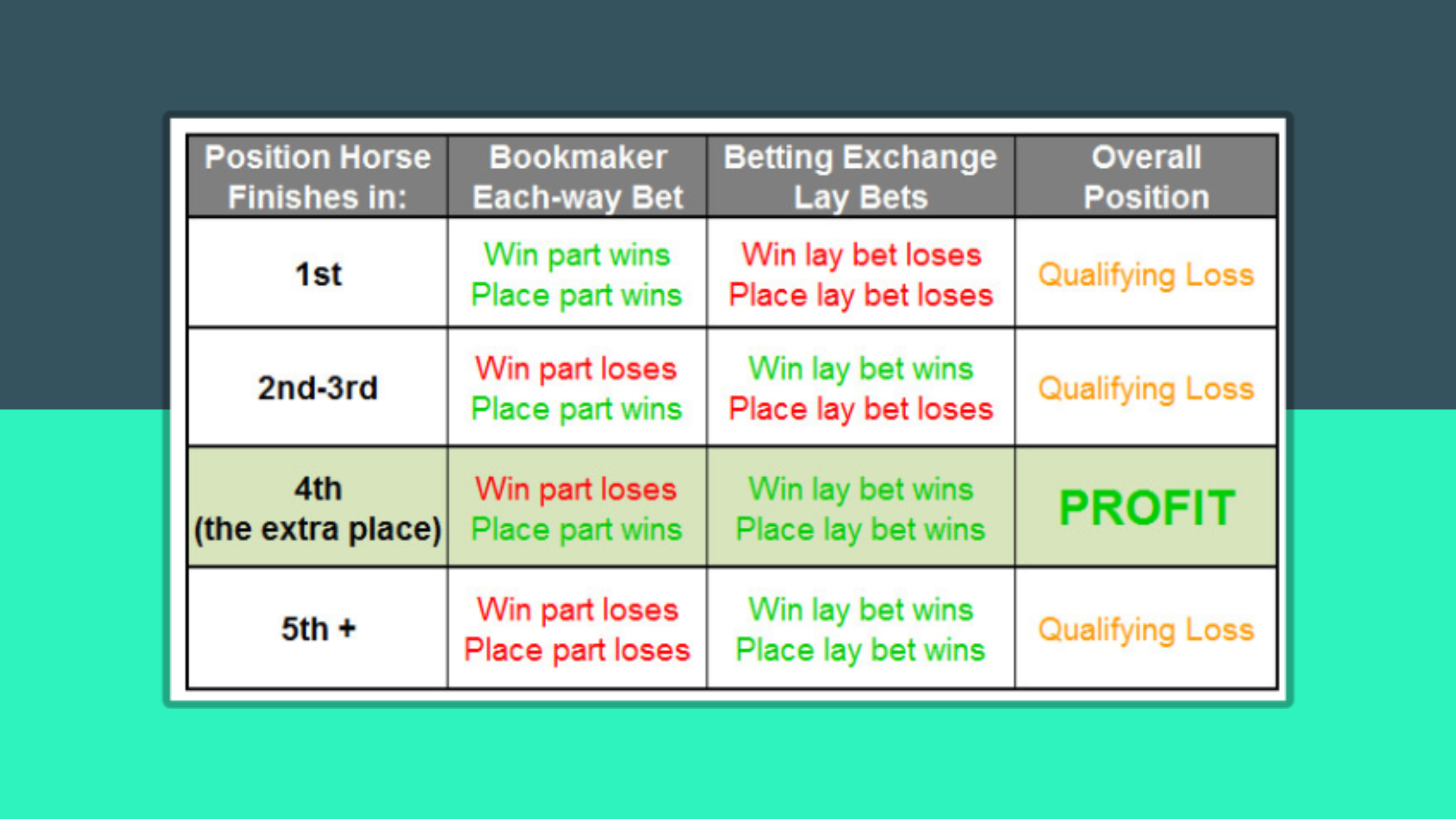
Your accumulated small qualifying losses will add up when you go on periods where your horses don’t come in at the “extra place”, however, over the long run the large profit you’ll make each time your horse does finish in the “extra place” will greatly outweigh the small losses. This is a long-term strategy and how profitable extra place betting works.
How Do Matched Betting Extra Place Offers Work?
To understand how extra place offers work you’ll first need to be confident placing each-way bets at the bookmakers and laying off these each-way bets at a betting exchange too.
What Are Each-Way Bets?
An each-way bet is two bets combined as one.
Half the total stake is being placed on the selection to win.
The other half is placed on the selection to place.
More specifically, in horse racing, it’s a bet on the horse to win AND a bet on the horse to place.
If you place a £5 each-way bet on a horse, the total cost of that each-way bet is £10. This is because £5 is on the horse to win and the other £5 is on the horse to finish in any of the place positions.
The odds for each horse to win are displayed in the bookmaker’s main race market. The place part of the bet is paid out as a fraction of these odds, typically one-fifth (⅕) of the win odds and sometimes a quarter (¼) of the win odds in smaller field size races.
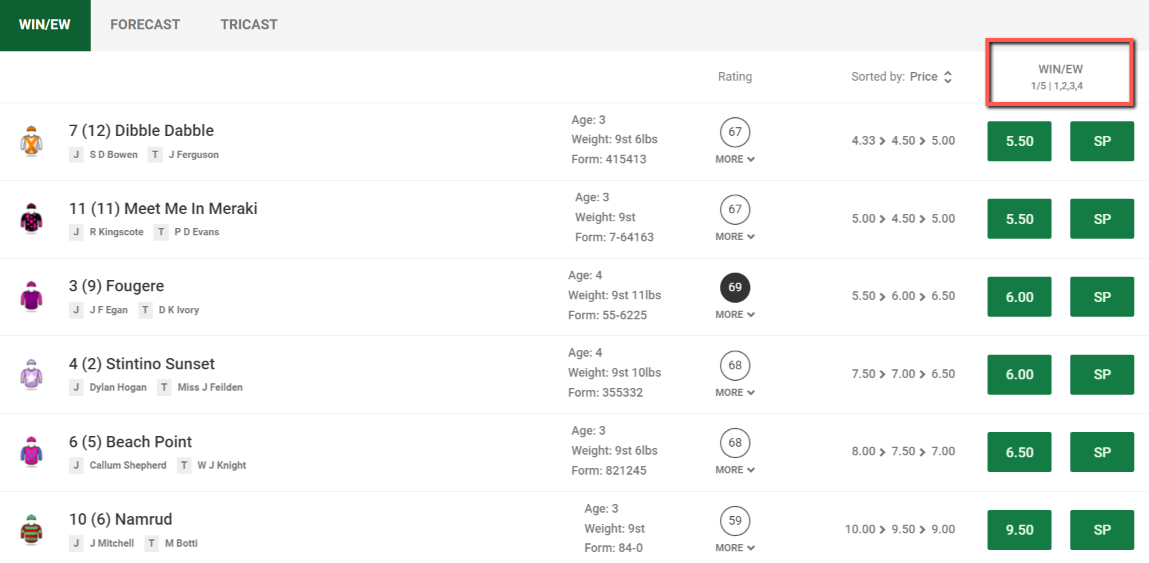
In this race, the place odds are ⅕ of the win odds and the place positions are 1st, 2nd, 3rd and 4th indicated by the 1,2,3,4 listing.
When Matched Betting these offers you won't need to understand how these place odds are calculated as you’ll be using simple each-way calculator that do all the work for you.
How To Place An Each-Way
To place an each-way bet, you need to select the odds for your horse in the normal bookmaker “win” market to add your selection to the bet slip.
You can then select that the bet will be an each-way bet in the bet slip. This is usually with a check-box, slider or similar but is always an option whenever an each-way bet is possible.
Remember that whatever amount you enter in the bet slip - your total stake will be double this amount. So if you want to place a £5 each-way bet, you’ll enter £5 as your stake and when you select the each-way option the total stake will be £10.
How To Lay An Each-Way Bet
To lay off an each-way bet that you’ve placed at a bookmaker, you must place two separate lay bets at the betting exchange.
Specifically - one lay bet on the win market, and one lay bet on the place market. This is because the each-way bet is essentially two bets in one - so you need to lay both parts off.
The each-way calculator will show you exactly what lay stakes you must use to lay off your each-way bet depending on the odds you used and the odds available at the betting exchange.

You can then copy the lay stakes and head to the win market and place market to place your two separate lay bets.

In most cases, you’ll be using the place market that pays one place less than the amount of places offered by the bookmakers. For example, if the bookmaker is offering to pay out on 4 places, you’ll use the “Place (3)” market to lay off the place part of your each-way bet.
There may be occasions where you can use the other place markets to your advantage - if a race is offering to pay 5 places for example, you have the choice to use the “Place (4)” market to lock in a smaller qualifying loss to leave 5th place as the extra place position or use the “Place (3)” market to take a higher qualifying loss but have two extra places positions of 4th and 5th to hit.
Where Does The Profit Come From?
You make a profit if your horse finishes in an extra place position due to the difference in the “place” classification between the bookmaker and the betting exchange.

You can see in this example, that you would make a 20p qualifying loss if your horse finished in any other position than 4th (the extra place).
If your horse did finish exactly 4th, you’d make a £15.80 profit.
Your implied odds are around 80 which is calculated by dividing the potential profit by the qualifying loss. This gives you the effective odds you’re getting by placing this each-way bet and laying it off.
Considering the horse is priced at odds of 12.0 (11/1) to win the race, your odds of 80.0 (79/1) to finish 4th are exceptional value! So even though you won't hit the extra place every time - by consistently taking high-value bets like this, you’ll ensure that you make a profit in the long run.
How To Find Profitable Extra Place Bets
Although there are many extra place offers available most days, they are not all profitable. It’s important to know what bets are worth it or not.
There are three main ways you can use to find profitable extra place bets.
Search Manually
You can use a free odds comparison site such as Oddschecker to compare odds between bookmakers and betting exchanges and enter them into the each-way calculator to see if an extra place bet is worthwhile.

Oddschecker displays the each-way terms of each bookmaker so you can see which sites are offering an extra place. In this case, you can see Sky Bet offering 5 places at ⅕ of the odds for the place part whereas most others offer 4 places at ⅕ of the odds.
This is a free way to find extra place bets but can be very time-consuming with no guarantee of finding any profitable opportunities.
Extra Place Catcher
Outplayed’s Extra Place Catcher is an advanced Matched Betting tool (available with Platinum and Diamond memberships) that assists you in maximising profits from horse racing extra place offers by helping you quickly find low-cost odds matches for extra place each-way bets.
The Extra Place Catcher shows all the races that have extra places available and calculates the stakes required for each stage of the backing and laying process.
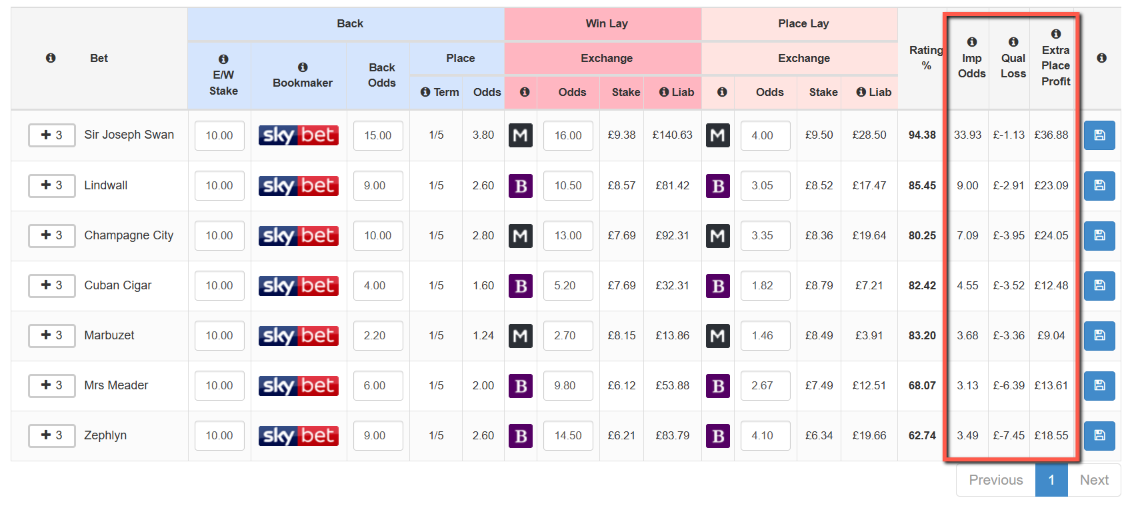
The software allows you to quickly see the implied odds, qualifying loss and extra place profit at a glance to help you identify which bets are worthwhile and which are not.
Once you have placed an each-way back bet you can copy the lay stakes shown on the software for the win and place lay and lay your extra place bet at a betting exchange.
Extra Place Master
The Extra Place Master (available with Outplayed Pro) is by far the most superior extra place tool in the Matched Betting industry for helping you identify profitable bets.
The software can accurately forecast the probability of a horse securing an extra place which means you can find consistent high-value bets.
The main difference between the Extra Place Catcher and Extra Place Master is that the former relies on using implied odds as the main indicator of whether a bet is good value or not.
Whilst implied odds can sometimes help to find value, the problem is that this doesn’t take into consideration how likely it is that a horse will achieve that extra place position.
For example, a heavy odds-on favourite or a distant outsider might only land in the extra place once in 100 attempts or less, so taking what appears to be good implied odds might actually be poor value.
Similarly, other horses might land in an extra place much more often despite their implied odds not being as high. This represents a huge amount of potential value missed by only relying on implied odds.
The Extra Place Master has revolutionised finding value in horse racing - it’s able to simulate the actual probability of a horse landing in an extra place position.
It does this using a proprietary algorithm which analyses every participant and the composition of the race to be able to very accurately approximate how likely a horse is to land in an extra place position.
The result - the Extra Place Master can determine with a high degree of accuracy whether a bet is plus or minus EV (expected value) and essentially if it’s worth doing or not.

The Extra Place Master gives you the actual value of your bets taking into consideration the expected value, the chance of the extra place as well as implied odds. Unlike other software, it factors in the composition of each race which includes each horse's odds relative to every other horse's odds.
The Extra Place Master has three modes that range from lower risk to higher risk.
.png)
Full Lay Mode
Full lay mode is for laying the win and the place part of your bet. This is the strategy we’ve talked about so far in this guide.
Using this mode, you’ll make a profit if your horse finishes in the extra place.
.png)
If your horse finishes in any other position, you’ll typically make a small qualifying loss.
Part Lay Mode
Part lay mode is for laying the win part of your bet but not the place part. This will help reduce the variance compared to the no lay mode and focuses on the high value often found in the place part of each way bets.
Using this mode, you’ll make a profit if your horse finishes in any place position, for example 1st, 2nd, 3rd or 4th.
If your horse finishes outside the place positions, you’ll typically make a small qualifying loss from the win part lay plus you’ll lose the place part of the each-way back bet.
No Lay Mode
No lay mode is for laying nothing and is the highest risk strategy but allows you to take the most value. You simply place an each-way back bet at the bookmaker.
Using this mode, depending on the odds, you’ll make a large profit if your horse wins or a moderate profit if your horse finishes in any place position.
You’ll lose all your each-way back stake amount if your horse finishes outside the place positions.
.png)
The no lay mode is for advanced value bettors only. You’ll need a large bankroll due to the big swings in profit/loss. It’s also important to always make sure to check that the bookmaker is still paying the number of places shown on the software.
Which Mode Should You Use?
The mode you use will depend on your experience, bankroll and tolerance to risk.
The full lay mode will be suitable for most users who prefer a lower-risk approach to extra place offers. This strategy still requires patience and a long-term mindset but downswings will be significantly shorter than using the other modes.
Although higher risk, the part lay and no lay modes have additional value compared to full lay mode and are especially useful when the exchange markets aren't well formed.
Keep in mind that using the part lay and no lay strategy are much higher variance than full lay and you’ll have larger positive and negative swings in profits. These modes are for advanced value bettors only and require a large bankroll.
The huge advantage of no lay mode is that it’s faster and more profitable in the long run. No lay mode will show horses that aren't necessarily from extra places races but still represent good value.
This means there’ll be way more value available and the process involves a quick each-way bet and then you can move to the next bet without having to lay your bets at the exchange.
To be very clear - the no lay strategy is very high risk so only suitable if you’re experienced and have a large bankroll that can tolerate the swings in profit. The variance you’ll experience is similar to that of high risk casino offers:
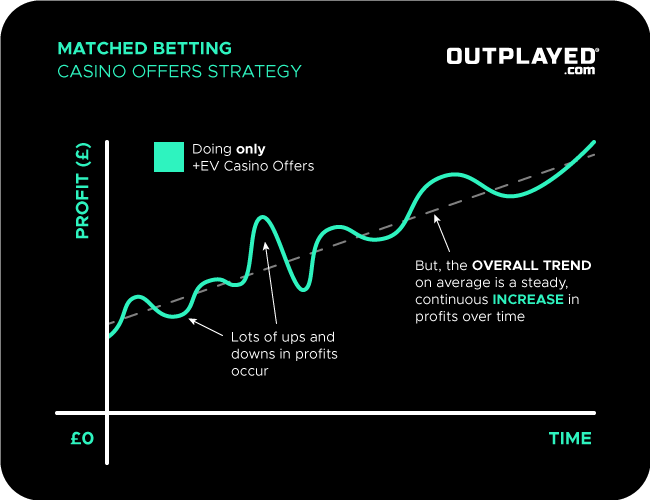
Step By Step Guide To Extra Place Offers
Now you know the basics, let's walk through how to place an extra place bet using the full lay strategy.
You’ll then be able to apply the same process when you’re ready to take on extra place offers.
1. Find A Profitable Extra Place Bet
Using the Extra Place Master or another tool you can find a suitable bet and open the calculator for the bet.

The Extra Place Master shows this bet has a positive expected value and implied odds of 39.0. Using a £10 each-way stake you’ll be risking 95p in total for a chance to profit £37.05 if the horse “Get The Music On” finishes in the extra place - 4th in this case.
2. Place Your Each-Way Back Bet
You can head to the bookmaker website which is Bet365 for this bet and navigate to the 15:55 Doncaster race.

After checking that the horse “Get The Music On” is still odds of 15.0 you can click on the odds to add the horse to your bet slip.
Enter your stake and be sure to select the each-way option shown here as E/W. Note that Bet365 are paying 4 places here, so you’ll need to lay the top 3 places at the betting exchange.
3. Place Your “Win” Lay Bet
With the back bet placed you’ll need to head to the betting exchange, in this case, it’s Matchbook.
Navigate to the 16:55 Doncaster race and select the lay odds for “Get The Music On” in the win market.
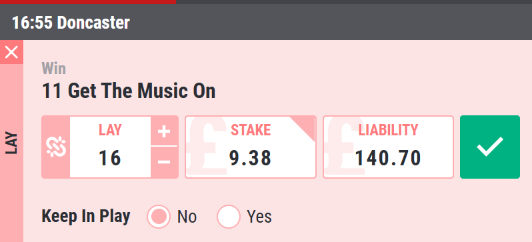
Enter the lay stake of £9.38 at odds of 16.0 as shown on the calculator.
If the lay odds have changed at all, you can head back to the calculator and update the odds to find out your new lay stake.
4. Place Your “Place” Lay Bet
You can now place your place lay bet using the “Place 3” market at Matchbook.
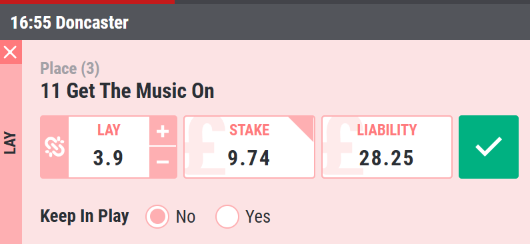
Enter the lay stake of £9.74 at odds of 3.9 as shown on the calculator.
Again, if the lay odds have changed, head back to the calculator and update the odds to find out your new lay stake.
Extra place bet placed and layed off!
Let’s take a look at your position with this bet depending on where “Get The Music On” finishes in this race.
1st: -£0.95 qualifying loss
2nd or 3rd: -£0.95 qualifying loss
4th: +£37.05 PROFIT
5th or higher: -£0.95 qualifying loss
5. Track Your Bet
As extra place offers are a long term offer, it’s important to track your progress to help keep you organised and motivated.
You can use the “Store” option on the Extra Place Master calculator to save each extra place bet you place.

Clicking Store will save your bet to the “My Bets” section of the Extra Place Master. This section will show all of the bets you've stored and all the useful information you need about them.

The My Bets section also has access to a very handy graph to show how your profits tally up with the value taken.

How Much Can You Make From Extra Place Offers?
Earning from extra place offers will vary depending on a few factors such as:
- The volume of bets you place
- Your bankroll size
- The software you use
- The strategy you choose
- Your level of experience
Many Outplayed members comfortable make over £500 profit each month using the Extra Place Master.
The main thing to focus on is the amount of EV you’re taking. Extra place betting is all about placing bets that have a positive EV (expected value) and will be a good indication of how much profit you can expect to make over the long run.
The Extra Place Master software shows EV for each horse meaning you can take the perfect profitable opportunities to help you increase your profits over the long run.
For example, if you’re using the no lay method and place a £10 total stake (£5 each way) on a horse that has an EV of 115%, you’d be taking £1.50 worth of value.
The percent value above 100% is your value so in this case, 15% of £10 would be £1.50 worth of value.
Keep in mind placing an each-way back bet takes a matter of seconds and you can place multiple bets at different bookmakers throughout the day to build up a large amount of EV. Using larger stakes will also increase the amount of value you’re taking if you have a large enough bankroll.
What Size Stakes Should You Use For Extra Place Offers?
Your stake size will depend on your tolerance to risk and what method you’re using.
The larger stake you use on a positive EV bet, the more value you'll take. If we use the same example using the no lay method and using a horse with an EV of 115%, if you used a £100 total stake (£50 each way), you’d be taking £15 worth of value.
As appealing as larger stakes might be with the no-lay method, you must manage your bankroll correctly. Ideally, you’ll only be risking 0.5 - 1% of your bankroll on any given bet and even lower if using bets with particularly higher odds.
If you’re only using the full lay method then your qualifying losses will be much smaller and manageable. Your bankroll will largely determine the size of your bets in relation to the amount of funds you have available in your betting exchange to lay your bets.
Beginner Tips For Getting Started With Extra Place Offers
You can follow our top tips to begin extra place offers to help you get off to a great start:
1. Ask questions before jumping in
Extra place offers are an advanced Matched Betting offer so we do recommend you take time to fully understand how they work before getting started.
Reading this ultimate guide is a great starting point and you can ask questions on the forum or speak to one of our Matched Betting experts on live chat or email if anything is unclear.
2. Start small and build up slowly
No matter what you’re Matched Betting bankroll is we’d advise starting extra place offers by using relatively small £1-2 each-way bet stakes at first until you get the hang of things and can quickly place your bets.
This means if the odds change quickly or you make a mistake, there will not be as much money at risk. As you become more confident, you can increase your stake size gradually.
3. Make sure you’re placing each-way bets correctly
This may sound simple but it’s important to remember to check you have selected an each-way bet in your bet slip before placing the bet as the place part of the bet is where the value is.
If you forget to select the each-way option you’ll be left with a win-only bet. If this happens you’ll need to either cash out the bet at the bookmaker or use a standard Matched Betting calculator to work out your lay stake at a betting exchange to take a small qualifying loss before placing the each-way bet correctly.
4. Focus on busy race days
Although there are extra place offers available every day through the week, try to stick to days where there are lots of bigger races taking place.
Examples of this would be on Saturdays when there is lots of televised racing or during horse racing festivals such as Cheltenham.
This will keep your bookmaker accounts healthy by blending in with regular punters and help you avoid being gubbed.
You’ll also find much higher value extra place opportunities on these busier days when there are lots of bookies competing with each other offering higher odds and more extra places as incentives.
5. Get 0% exchange commission
The key to extra place offers is to make sure you’re taking good value bets, you can pay 0% commission with both Smarkets and Matchbook to help you take more value by locking in smaller qualifying losses.
Your Extra Place Offers Questions Answered
Extra place offers are a super profitable type of reload offer so it’s no surprise we get asked a lot of questions about them. We’ve answered our most frequently asked extra place offers queries here:
Can Anyone Do Extra Places?
Extra Places are an advanced Matched Betting strategy so we strongly suggest having a minimum £1000 bankroll. Ideally, you’ll have much more.
You should have - at the very least - completed all the signup offers and have a strong understanding of the basics of Matched Betting.
If you aren’t quite at that stage yet, don’t worry! You can start by learning how to do horse racing refund offers first as these are a nice introduction to Matched Betting with horse racing.
Can I Use Gubbed Accounts To Do Extra Place Offers?
Absolutely. To our knowledge, if you haven’t been notified by a specific bookmaker, they all pay out extra places - with the exception of BoyleSports and BetVictor*.
This makes extra place offers a fantastic way to use your gubbed accounts!
You may find that you are stake-restricted on a gubbed account but you'll still be paid out for extra places (unless it's with BoyleSports or BetVictor).
*We’ve heard of reports of payouts with both Boylesports and BetVictor so you’ll need to test your own accounts with small stakes to know for sure.
How Many Extra Place Bets Should You Place A Day?
The larger the volume of worthwhile extra place bets you place the better as you’ll be taking more value. But start slowly and build up if you;re brand new to extra place offers.
It’s also good practice to only place one bet per race at each bookmaker to avoid standing out as a Matched Bettor.
You may be able to still bet on multiple horses in one race to give you more chance of hitting an extra place by using multiple bookmakers. This is possible during busy festivals and Saturdays when lots of bookies are paying out extra places.
Doing this means you can take advantage of shared liability at your betting exchange.
Can I Use Shared Liability To Make The Most Out Of My Bankroll?
Yes absolutely! There are often several bookies offering extra places for the same race.
This means you could potentially cover multiple horses with the use of shared liability.
Shared liability comes into play when you have lay bets on different selections of the same event on the same exchange.
When all these outcomes can't occur, the amount of liability is reduced.
For example, in a specific horse race, you have lay bets against Horse A and also Horse B, both Horse A and Horse B can't win. As a result, your liability will be much lower than you may have initially thought.
Useful to know: If you’re doing each-way bets on horse-racing offers shared liability on the “place” markets won't occur until after you've bet on more horses to place than there are available places.
For example, if you are laying the “Place 3” market, shared liability won't occur until you are laying off a 4th horse in that market. Shared liability basically comes into force when it's impossible for all the lay bets to lose.
It's possible for 3 horses to finish in 1st, 2nd and 3rd, but impossible for 4 horses to do so.
Do More Extra Places Mean More Value?
Yes, it can. If a bookie is offering more than one extra place then this is brilliant for you as a Matched Bettor.
For example, if Sky Bet are offering 5 places and the exchange is 3 places, you’ll make a profit if your horse comes 4th OR 5th.
This means you have double the chance to hit the extra place compared to if they were offering one extra place.
If you have two horses in the Extra Place race and both hit 4th and 5th - then you're in for even more profits!
What Is The Minimum Number Of Runners Required For The Extra Place?
If a race starts with too few runners, then the bookie will drop the number of places that they'll pay out on each-way bets.
This makes it important to have a good idea of how many runners are needed for the bookie to still pay out the extra place.
This changes based on the bookie and the race in question, but you can find more information and a minimum runner table here.
What Happens If The Odds Move Quickly Just Before The Race Starts?
The bookmaker and betting exchange odds will move rapidly just before the start of races.
You can find great odds matches just before the race starts. But it can open you up to the risk of losing money with unmatched bets.
If you want to play it safe, then it’s important to get your bets sorted well before the race start time. We’d recommend newbies always make sure their bets are matched comfortably before the race starts.
Got Another Question on Extra Places?
We’ve got you covered!
Please get in touch and our amazing customer support team will be happy to help. You can speak with us on live chat 9am - 5:30pm seven days a week.
Or drop an email, every single email gets read and responded to personally by our Matched Betting experts typically within 24 hours.
Updated: 5 Mar 2025
The Author
Ben is an expert in Matched Betting with nearly a decade of hands-on experience. He enjoys sharing his knowledge and is dedicated to creating high-quality, beginner-friendly content that educates and informs readers about the amazing opportunity that Matched Betting is.

